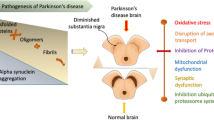Summary
A number of hypotheses on the etiology of Parkinson's disease and other CNS disorders postulate a role of metal ions and/or neuromelanin. As part of an investigation of the interactions between neuromelanin and metal ions, we have studied the amount and type of metal ions in human neuromelanin in intact substantia nigra and in isolated neuromelanin using electron paramagnetic resonance (EPR), which selectively measures metal ions which are in valence states that have unpaired electrons and total reflection X-ray fluorescence (TXRF), which measures total metals. EPR also is a principal technique for studying the biophysics of melanins by analysis of its free radicals. The studies of substantia nigra with TXRF indicated the presence of substantial amounts of iron, zinc, lead, copper, maganese, and titanium at concentrations up to 4 times greater than those of non-pigmented brain tissue (basis pedunculi). The concentrations of metal ions in isolated neuromelanin were 5–260 times higher than in substantia nigra. The studies with EPR indicated that there were substantial amounts of paramagnetic metals ions, especially iron, bound to neuromelanin in intact substantia nigra, and the presence of these metal ions modified the EPR spectra of the free radicals of neuromelanin. We conclude: 1. Compared to other regions of the mid-brain, the substantia nigra contains increased amounts of many different metal ions; 2. Many of these metal ions are in paramagnetic valence states; 3. There are high concentrations of paramagnetic metal ions bound to neuromelanin. These results are consistent with the hypotheses that postulate a role of metal ions in promoting oxidative reactions in pigmented neurons.
Similar content being viewed by others
References
Adams JD, Odunze IN (1991) Oxygen free radicals and Parkinson's disease. Free Rad Biol Med 10: 161–169
Barden H (1969) The histochemical relationship of neuromelanin and lipofuscin. J Neuropathol Exp Neurol 28: 419–441
Ben-Shachar D, Youdim MBH (1990) Selectivity of melanized nigra-striatal dopamine neurons to degeneration in Parkinson's disease may depend on iron-melanin interaction. J Neural Transm [Suppl 29]: 251–258
Carstam R, Brinck C, Hindemith-Augustsson A, Rorsman H, Rosengren E (1991) The neuromelanin of the human substantia nigra. Biochim Biophys Acta 1097: 152–160
Cohen G (1986) Monoamine oxidase, hydrogen peroxide, and Parkinson's disease. Adv Neurol 45: 119–124
Cotzias GC, Papavasiliou PS, Van Woert MH, Sakamato A (1964) Melanogenesis and extrapyramidal disorders. Fed Proc 233: 713–718
Dexter DT, Wells FR, Lees AJ, Javoy-Agid F, Agid Y, Jenner P, Marsden CD (1989) Increased nigral iron content and alterations in other metal ions occurring in brain in Parkinson's disease. J Neurochem 52: 1830–1836
Fahn S (1989) The endogenous toxin hypothesis of the etiology of Parkinson's disease and a pilot trial of high-dosage antioxidants in an attempt to slow the progression of the illness. Ann NY Acad Sci 570: 186–196
Götz ME, Freyberger A, Riederer P (1990) Oxidative stress: a role in the pathogenesis of Parkinson's disease. J Neural Transm [Suppl 29]: 241–249
Hirsch EC, Graybiel AM, Agid Y (1988) Melanized dopaminergic neurons are differentially susceptible to degeneration in Parkinson's disease. Nature 334: 345–348
Hirsch EC, Brandel MP, Galle P, Javoy-Agid F, Agid Y (1991) Iron and aluminum increase in the substantia nigra of patients with Parkinson's disease: an X-ray microanalysis. J Neurochem 56: 446–451
Hornykiewicz O (1986) Biochemical pathophysiology of Parkinson's disease. Adv Neurol 45: 19–22
Marsden CD (1983) Neuromelanin and Parkinson's disease. J Neural Transm [Suppl 19]: 121–141
Nicolaus RA (1968) Melanins. Herman, Paris
Pilas B, Sarna T, Kalyanaraman B, Swartz HM (1988) The effect of melanin on iron associated decomposition of hydrogen peroxide. Free Rad Biol Med 4: 285–293
Prota G (1980) Recent advances in the chemistry of melanogenesis in mammals. J Invest Derm 75: 122–127
Riederer P, Sofic E, Rausch WD, Schmidt B, Reynolds GP, Jellinger K, Youdim MBH (1989) Transition metals, ferritin, glutathione and ascorbic acid in parkinsonian brain. J Neurochem 52: 515–520
Sealy RC, Felix CC, Hyde JS, Swartz HM (1980) Structure and reactivity of melanins: influence of free radicals and metal ions. Free Rad Biol 4: 210–251
Sofic E, Riederer P, Heinsen H, Beckmann H, Reynolds GP, Hebenstreit G, Youdim MBH (1988) Increased iron (III) and total iron content in post-mortem substantia nigra of parkinsonian brain. J Neural Transm 74: 199–205
Swartz HM, Bolton J, Borg D (eds) (1972) Biological applications of electron spin resonance. Wiley, New York
Swartz HM, Sarna T, Zecca L (1992) Modulation by melanin of the availability and reactivity of metal ions. Ann Neurol 32: S69-S75
Van Woert MH, Prasad KN, Borg DC (1967) Spectroscopic studies of substantia nigra pigment in human subjects. J Neurochem 14: 707–716
Youdim MBH, Ben-Shachar D, Riederer P (1989) Is Parkinson's disease a progressive siderosis of substantia nigra resulting in iron and melanin-induced neurodegeneration? Acta Neurol Scand 126: 47–54
Zecca L, Parati E, Mecacci C, Seraglia R (1992) The chemical characterization of melanin contained in substantia nigra of human brain. Biochim Biophys Acta 1138: 6–10
Author information
Authors and Affiliations
Rights and permissions
About this article
Cite this article
Zecca, L., Swartz, H.M. Total and paramagnetic metals in human substantia nigra and its neuromelanin. J Neural Transm Gen Sect 5, 203–213 (1993). https://doi.org/10.1007/BF02257675
Received:
Accepted:
Issue Date:
DOI: https://doi.org/10.1007/BF02257675




